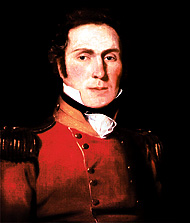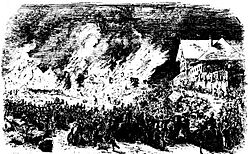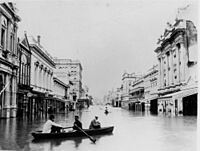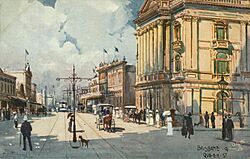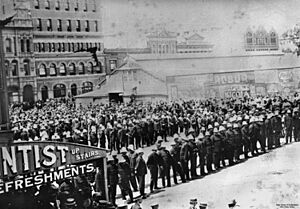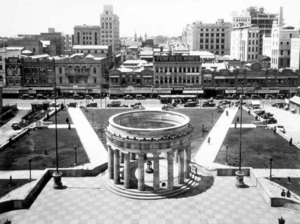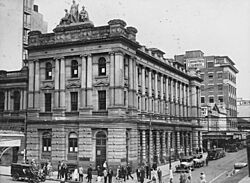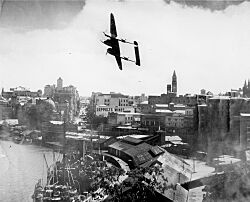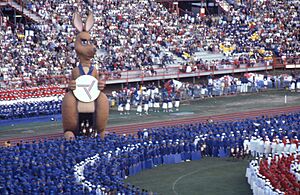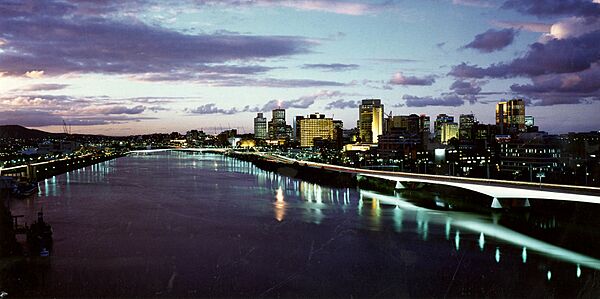History of Brisbane facts for kids
The history of Brisbane officially began in 1799. That's when Matthew Flinders explored Moreton Bay during a trip from Port Jackson. However, the area was already home to the Yugara and Turrbal Aboriginal tribes for a very long time.
Brisbane started as a prison colony for British convicts sent from Sydney. But it was a good place for fishing, farming, and getting timber. So, in 1838, it was opened for free settlers. The town became a self-governing area in 1859. By 1924, it grew into a big city area. Brisbane has faced major floods in 1893, 1974, 2011, and 2022. Many US soldiers were based in Brisbane during World War II. The city also hosted the 1982 Commonwealth Games, World Expo 88, and the 2014 G20 Brisbane summit.
Contents
Why is Brisbane Called Brisbane?
The city of Brisbane is named after Sir Thomas Brisbane (1773–1860). He was the Governor of New South Wales from 1821 to 1825. When the town was named in 1834, it was still part of the Colony of New South Wales. This was after it stopped being a prison colony.
Sir Thomas Brisbane was a British Army officer and a scientist who studied stars. He was born in Scotland. The name Brisbane comes from a Scottish family name. It might come from old French words meaning "break bone."
Brisbane Before Europeans Arrived
Before Europeans settled, the Brisbane area was home to Aboriginal tribes. These included the Yugara, Turrbal, and Quandamooka peoples. The oldest known Aboriginal site in the Brisbane area is at Wallen Wallen Creek. It is on North Stradbroke Island and is about 21,800 years old. People likely lived there much earlier than that.
The land, the Brisbane River, and its smaller streams provided everything needed for life. The river had lots of food like fish, shellfish, crabs, and prawns. Good fishing spots became places where groups camped and did activities together. The area had open woodlands with some rainforests along the river bends.
Brisbane was a rich area for resources and a natural path for people moving seasonally. It was a stop for groups traveling to ceremonies. The region had several large seasonal camps for 200 to 600 people. The most important ones were along waterways north and south of the city center. These included Barambin (now Victoria Park) and Woolloon-cappem (now Woolloongabba/South Brisbane). These camping grounds were still used when Europeans arrived. They even became the basis for some European settlements in Brisbane.
European Exploration in the 1700s
In 1770, British explorer James Cook sailed through the South Passage. This passage leads to the bay, which he named 'Moreton' after James Douglas, the Earl of Morton.
Europeans first explored the region in 1799. Matthew Flinders explored Moreton Bay during his trip north from Port Jackson. He landed at Woody Point in Redcliffe. He also visited Coochiemudlo Island and Pumicestone Passage. Flinders spent fifteen days in Moreton Bay but could not find the Brisbane River.
Brisbane in the 1800s
Finding the Brisbane River
A permanent settlement was not started until 1823. This was when New South Wales Governor Thomas Brisbane was asked by free settlers in Sydney to send their worst convicts somewhere else. The area chosen became the city of Brisbane.
On October 23, 1823, Surveyor General John Oxley set out from Sydney. He was on a mission to find places for new convict settlements. He reached Port Curtis (now Gladstone) but thought it was not a good spot.
As he neared Moreton Bay, he saw some Indigenous Australians. He noticed one man was much lighter in color. This turned out to be Thomas Pamphlett, a shipwrecked timber worker. He and three others had been shipwrecked on Moreton Island and lived with an Indigenous tribe for seven months.
After meeting them, Oxley traveled about 100 kilometers (62 miles) up a river. He named it the Brisbane River to honor the governor. Oxley explored the river as far as Goodna, about 20 kilometers (12 miles) upstream from Brisbane's city center. He named several places, including Breakfast Creek, Oxley Creek, and Seventeen Mile Rocks.
The early settlement faced many diseases in the late 1820s.
The Convict Colony (1824-1838)
In 1824, the first convict colony was set up at Redcliffe Point. But just one year later, in 1825, the colony moved south. It moved to a bend in the Brisbane River, where Brisbane's city center is today. The Turrbal people called this place "Meen-jin."
By the end of 1825, Brisbane had 45 men and 2 women. Until 1859, when Queensland became a separate state from New South Wales, the area was called Moreton Bay. A different name, "Edenglassie," was first suggested for the town. But the name Brisbane, honoring Governor Thomas Brisbane, was chosen instead.
The colony was a "prison within a prison." It was far from Sydney and used to punish convicts who had re-offended. It became known as one of the toughest prison settlements in New South Wales. In July 1828, work began on the Commissariat Store. This building is still standing today as a museum. The other surviving convict building is The Old Windmill on Wickham Terrace, built in 1828.
Over twenty years, thousands of convicts passed through the prison colony. Many tried to escape the harsh conditions. Most escapes failed, or the convicts died in the bush. But some, like James Davis, managed to live among the Aboriginal people.
During these years, the local Aboriginal people tried to "starve out" the settlement. They did this by destroying its crops, especially their "corn fields" at today's South Bank. In return, the colony guards killed Aboriginal people who entered the corn fields.
Brisbane Becomes a Free Settlement
For many years, Brisbane was a prison colony, so private settlements were not allowed nearby. As fewer new convicts arrived, the population dropped. By the early 1830s, the British government questioned if Brisbane was still a good prison colony. Allan Cunningham found a route to the fertile Darling Downs in 1828. This, along with the need for a farming industry and Australian wool, led to the area opening up. In 1838, the area was opened to free settlers, not just convicts. A group of Lutheran missionaries from Germany were given land in what is now Nundah.
In 1839, the first surveyors arrived to prepare the land for more European settlers. From the 1840s, settlers used the abundant timber in local forests. Once cleared, the land was quickly used for grazing animals and other farming. The convict colony eventually closed.
In 1841, the Brisbane River flooded, rising over eight meters (26 feet). This caused a lot of damage to the colony.
The free settlers did not recognize the Aboriginal people's ownership of the land. They were not required to pay the Turrbal Aboriginals for it. This led to serious conflicts. Leaders like Yilbung tried to get regular payments from the white settlers. This was to help his people, whose resources had been greatly reduced by the settlers. By 1869, many Turrbal people had died from gunshots or disease. However, local newspapers often mentioned Indigenous people working and living in the area. Between the 1840s and 1860s, the settlement relied more and more on goods traded with Aboriginal people. These included firewood, fish, crabs, and shellfish. They also relied on services like carrying water, cutting trees, building fences, and helping with livestock. Some Turrbal people escaped the region with the help of Thomas Petrie. The suburb of Petrie is named after him.
Scottish immigrants arrived in Brisbane in 1849 on the ship Fortitude. They were promised free land grants. When they didn't get the land, they camped at York's Hollow (now Victoria Park). Some of these immigrants later settled a suburb and named it Fortitude Valley after their ship.
The Roman Catholic church built the Pugin Chapel in 1850. It was designed by Augustus Pugin, who was visiting the city.
Brisbane Becomes a Capital City
On September 6, 1859, Brisbane was declared a Municipality. The first council elections were held the next month. John Petrie became Brisbane's first mayor. On December 10, 1859, Queensland officially separated from New South Wales. Sir George Ferguson Bowen became Queensland's first governor, and Brisbane was chosen as the capital. Old Government House was built in 1862 for Sir George Bowen's family. It is believed that the famous Australian dessert, the Lamingtons, might have originated here.
The City Botanic Gardens were started in 1825 as a farm for the prison settlement. Convicts planted food crops there. In 1855, some land was set aside as a Botanic Reserve. Walter Hill was the superintendent until 1881. He planted some of the oldest trees in the Gardens. These were the first of their kind in Australia. Hill experimented to help plants get used to the climate. By 1866, he had expanded the Gardens to about 27 acres. He brought in the jacaranda and poinciana trees, which are still popular in Queensland. It is even said that all jacaranda trees in Australia came from a seed Hill imported in 1864.
In 1864, the Great Fire of Brisbane swept through the city center. It destroyed over 100 buildings. After the fire, new buildings in the city center were mostly made of brick and stone instead of wood. The 1860s were a tough time with high unemployment. In 1866, hundreds of poor workers rioted and tried to break into the Government store.
The 1880s brought a time of economic growth and a big building boom in Brisbane. Many important public and commercial buildings were constructed. Fort Lytton was built in 1882 at the mouth of the Brisbane River. It was meant to protect the city from foreign powers. It was the only moated fort ever built in Australia.
In 1888, there were anti-Chinese riots in Frog's Hollow. More than 2,000 people attacked Chinese homes and businesses.
The 1893 Black February floods caused severe damage to the city. The raging floodwaters destroyed the first Victoria Bridge. Even though gold was found north of Brisbane, most of the money went to Sydney and Melbourne. Brisbane remained a smaller regional town. In 1896, the Brisbane River had its worst boat accident. The ferry Pearl capsized, and only 40 of the 80-100 people on board survived.
Electric streetlights were first demonstrated on Queen Street in 1882. This was the first recorded use of electricity for public purposes in the world. The first railway in Brisbane was built in 1879. It connected Ipswich to Roma Street Station. Horse-drawn, then electric trams, ran in Brisbane from 1885 until 1969.
Brisbane in the 1900s
When the Australian colonies united to form the Federation of Australia in 1901, Brisbane celebrated. A special arch was built in Queen Street. In May that year, the Duke of Cornwall and York (who later became King George V) laid the foundation stone for St John's Cathedral. The University of Queensland was founded in 1909. It was first located at Old Government House. Fernberg House, built in 1865, became the temporary and then permanent government house in 1910.
In 1902, Brisbane was officially named one of Queensland's first three cities.
On January 18, 1912, tram workers were suspended for wearing union badges. This led to Australia's first General strike, the 1912 Brisbane General Strike, which lasted five weeks. The first ceremony to honor soldiers who died at Gallipoli was held at St John's Cathedral on June 10, 1915. This tradition later grew into the popular Anzac Day ceremony.
During World War I, in 1917, the Australian Government raided the Queensland Government Printing Office. They wanted to take copies of records that showed anti-conscription ideas.
Many Russians came to Australia between 1911 and 1914. They were often seeking safety from political problems in Russia. Many were Jewish people escaping attacks. They traveled through Siberia and China, then sailed from Dalian to Townsville or Brisbane.
After World War I, returned soldiers focused on people they thought were disloyal to Australia. From 1918 to 1919, there were violent protests and attacks called the Red Flag riots in Brisbane. The most famous event was on March 24, 1919. About 8,000 ex-servicemen clashed with police who stopped them from attacking the Russian Hall in South Brisbane. This was known as the 'Battle of Merivale Street'.
To prevent overcrowding, the Queensland Parliament passed a law in 1885. This law, along with good public transport like trains and trams, encouraged the city to spread out. New housing developments grew along tram and train routes in suburbs like West End, Fortitude Valley, New Farm, Paddington, and Ashgrove.
This growth continued into the 1950s. As cars became more affordable, land between tram and train routes was developed. This led to new suburbs like Ekibin, Tarragindi, and Wavell Heights.
Brisbane Becomes a "Greater" City
In 1924, a new law was passed. It combined the City of Brisbane and many surrounding towns and shires into one big area. This formed the current City of Greater Brisbane in 1925, now simply called the City of Brisbane.
To fit the new, larger city council, the current Brisbane City Hall was opened in 1930. Many old town halls became public libraries. During the Great Depression, big projects were started to give jobs to unemployed people. These included building the William Jolly Bridge and the Wynnum Wading Pool.
After the death of King George V in 1936, Albert Square was made bigger and renamed King George Square. A statue of the king and two bronze lion sculptures were revealed in 1938.
In 1939, armed farmers marched on the Queensland Parliament. They stormed the building, trying to take the Queensland Government hostage. This event was known as the 'Pineapple Rebellion'.
During the late 1930s, construction of the Story Bridge continued. It was opened on July 6, 1940.
Brisbane During World War II

Brisbane was very important during World War II because it was close to the war zone in the Pacific. Thousands of Australian and American soldiers temporarily lived in the city. Many buildings were used to house military personnel.
The MacArthur Central building became the Pacific headquarters for U.S. General Douglas MacArthur. The University of Queensland campus at St Lucia was turned into military barracks for the last three years of the war. Other schools like St Laurence's College and Somerville House Girls' School were also used by American forces.
Brisbane was part of the "Brisbane Line," a controversial defense plan. This plan suggested that if Australia was invaded, the northern part of the country would be given up. The line was supposedly just north of Brisbane. There are still cement bunkers and gun forts from this time in Brisbane's northern suburbs.
On November 26 and 27, 1942, fights broke out between US and Australian soldiers in Brisbane. One Australian soldier died, and hundreds of soldiers and civilians were injured. This event, called the Battle of Brisbane, was kept secret at the time.
Brisbane After the War
Right after the war, the Brisbane City Council struggled to find money for repairs and development. Even when funds were available, building materials were hard to find. Adding to these problems, some council members wanted to lower city taxes, which made financial difficulties worse.
Brisbane's tram system continued to grow, but many roads were still unsealed. Water supply was limited, even though the City Council built and raised the Somerset Dam. Most homes still relied on rainwater stored in tanks.
The limited water supply also meant that sewage systems were not updated. Most of Brisbane, outside the city center, used "thunderboxes" (outdoor toilets) or septic tanks.
Any money the council could get was used to build the Tennyson Powerhouse and upgrade the powerhouse in New Farm Park. This was to meet the growing demand for electricity. Brisbane's first modern apartment building, Torbreck, was finished in 1960.
Work on a city plan was slow. The first city plan was adopted in 1965.
In 1961, Clem Jones was elected Lord Mayor. He and the town clerk, J.C. Slaughter, worked to fix the city's long-term problems. They found ways to save money. For example, new sewers were laid shallower to save costs. They also built smaller, local sewage treatment plants around the city.
They were also lucky that it became easier to get money. By the 1960s, the city's tax base had grown enough to cover big expenses.
Under Jones's leadership, the City Council's transport plans changed a lot. They hired American consultants to create a new transport plan. Their report, the "Brisbane Transportation Study" (1965), suggested closing most suburban railway lines and the tram network. It also suggested building a huge network of freeways. The suburb of Woolloongabba would have been almost destroyed by a massive freeway interchange. In 1962, the Paddington tram depot fire destroyed 67 trams, about 20% of the fleet. This fire generally marked the beginning of the end for trams in the city. Trams were quickly removed between 1968 and 1969. However, only one freeway was built, and the trains were kept and later made electric.
The 1974 Brisbane flood was a major disaster that temporarily shut down the city. It also caused a large landslip at Corinda.
Between 1968 and 1987, Queensland was led by Joh Bjelke-Petersen. His government was known for being socially conservative and for using police force against protesters. This period ended with an investigation into police corruption. During this time, Brisbane developed a counterculture, especially around the University of Queensland, street marches, and Brisbane punk rock music.
In the late 1970s, Brisbane faced many forms of censorship. In September 1977, the government banned all street protests. This led to a campaign of defiance, where two thousand people were arrested and fined. Another hundred were imprisoned.
The Fitzgerald Inquiry from 1987 to 1989 investigated Queensland Police corruption. This investigation led to the Premier (head of government) resigning. It also resulted in three former ministers and the Police Commissioner being jailed. It helped end the National Party of Australia's 32-year rule in Queensland.
Brisbane in the 1980s
Brisbane hosted the Commonwealth Games in 1982 and the World's Fair in 1988. The city electrified its rail network during the 1970s and 1980s. The Queensland Cultural Centre was redeveloped. The Queensland Art Gallery was completed in 1982, the Queensland Performing Arts Centre in 1985, and the Queensland Museum in 1986. Between the late 1970s and mid-1980s, Brisbane was a center for early land rights protests. There were also clashes between students, union workers, police, and the government. From this time, new Brisbane music groups, especially Punk bands, became well-known. In 1984, the Silver Jubilee Fountain sank into the Brisbane River. It had been working since Queen Elizabeth II's visit in March 1977.
Later in the 1980s, new rules for pollution greatly improved the city's air quality. Banning backyard incinerators in 1987 and closing two local coal power stations in 1986 helped. Lead levels in petrol also decreased by 50%. Brisbane's population grew much faster than the national average in the last two decades of the 20th century. Many people moved from Victoria and New South Wales. In the late 1980s, Brisbane's inner-city areas faced economic problems and crime. This caused people and businesses to move to the suburbs. In the early 1990s, the city successfully renewed the old Woolstore area in Teneriffe.
Brisbane in the 2000s
The South East Busway was built in 2000. After thirty years of fast population growth, Brisbane was hit by another major flood in January 2011. The Brisbane River did not rise as high as in the 1974 flood, but it still caused a lot of damage.
The Queensland Cultural Centre was also expanded. The State Library and the Gallery of Modern Art were completed in 2006. The Kurilpa Bridge was built in 2009. Brisbane also hosted big international events. These included the final Goodwill Games in 2001, the Rugby League World Cup final in 2008 and 2017, and the 2014 G20 Brisbane summit.
The city had a severe hailstorm in 2014 that caused a lot of damage.
Population growth has continued to be very high in the 21st century. Major new projects have been completed or are being built. These include the Howard Smith Wharves, Roma Street Parklands, the Brisbane Riverwalk, the Queen's Wharf casino and resort, and several road tunnels. New railway lines like the Airport, Springfield, and Redcliffe Peninsula lines have also been built. The Cross River Rail is currently under construction. In 2019, the Brisbane Skytower became the tallest building in the city.
Brisbane is scheduled to host the 2032 Summer Olympics and Paralympics.
Images for kids
See Also
- Timeline of Brisbane
- History of Queensland
- History of association football in Brisbane, Queensland
- History of electricity supply in Brisbane


